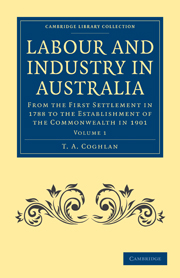 Labour and Industry in Australia
Labour and Industry in Australia Book contents
- Frontmatter
- PREFACE
- Contents
- PART I FROM THE FOUNDATION OF SETTLEMENT TO THE CROSSING OF THE MOUNTAINS
- PART II FROM THE CROSSING OF THE MOUNTAINS TO THE ABOLITION OF THE ASSIGNMENT SYSTEM
- I INTRODUCTION TO THE SECOND PERIOD
- II CONVICT LABOUR: ASSIGNMENT
- III FREE LABOUR
- IV IMMIGRATION
- V THE OCCUPATION OF LAND
- VI AGRICULTURAL AND PASTORAL PURSUITS
- VII THE CURRENCY
- VIII TRADE AND PRICES
- PART III FROM THE ABOLITION OF THE ASSIGNMENT SYSTEM TO THE DISCOVERY OF GOLD
- PART IV FROM THE DISCOVERY OF GOLD TO THE INTRODUCTION OF FREE SELECTION OF LAND BEFORE SURVEY
VI - AGRICULTURAL AND PASTORAL PURSUITS
Published online by Cambridge University Press: 05 August 2011
- Frontmatter
- PREFACE
- Contents
- PART I FROM THE FOUNDATION OF SETTLEMENT TO THE CROSSING OF THE MOUNTAINS
- PART II FROM THE CROSSING OF THE MOUNTAINS TO THE ABOLITION OF THE ASSIGNMENT SYSTEM
- I INTRODUCTION TO THE SECOND PERIOD
- II CONVICT LABOUR: ASSIGNMENT
- III FREE LABOUR
- IV IMMIGRATION
- V THE OCCUPATION OF LAND
- VI AGRICULTURAL AND PASTORAL PURSUITS
- VII THE CURRENCY
- VIII TRADE AND PRICES
- PART III FROM THE ABOLITION OF THE ASSIGNMENT SYSTEM TO THE DISCOVERY OF GOLD
- PART IV FROM THE DISCOVERY OF GOLD TO THE INTRODUCTION OF FREE SELECTION OF LAND BEFORE SURVEY
Summary
When Macquarie left Australia he was able to congratulate himself on the prospects of agriculture both in Van Diemen's Land and in New South Wales, and the probable independence of both colonies of outside assistance as regards food supplies. So far as Van Diemen's Land was concerned his forecast was correct, but not so for New South Wales. In the last-named colony there were at the time of Macquarie's departure some 32,300 acres cleared and under tillage; twelve years later, during which period about 3,500,000 acres of land had passed into private hands, the tilled area barely exceeded 60,000 acres; while in Van Diemen's Land the 15,000 acres cultivated in 1821 had been more than quadrupled during the same period. The island soon became the granary of Australia and the source from which it derived a large share of its supplies. There were several causes to which the poor progress of agriculture in New South Wales might be attributed, but certainly the most potent of all was the attraction of pastoral pursuits, which were an ever-present menace to agriculture. After the mountains had been crossed and the wide plains beyond opened to settlement, agriculture ceased to have any attraction for the more enterprising settlers, who all turned to pastoral life with its freedom and infinite possibilities, and though agriculture continued to be followed, it was without enthusiasm.
- Type
- Chapter
- Information
- Labour and Industry in AustraliaFrom the First Settlement in 1788 to the Establishment of the Commonwealth in 1901, pp. 249 - 256Publisher: Cambridge University PressPrint publication year: 2011First published in: 1918


